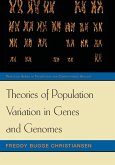Recent developments in molecular and computational methods have made it possible to identify the genetic basis of any biological trait, and have led to spectacular advances in the study of human disease. This book provides an overview of the concepts and methods needed to understand the genetic basis of biological traits, including disease, in humans. Using examples of qualitative and quantitative phenotypes, Professor Weiss shows how genetic variation may be quantified, and how relationships between genotype and phenotype may be inferred. This book will appeal to many biologists and biological anthropologists interested in the genetic basis of biological traits, as well as to epidemiologists, biomedical scientists, human geneticists and molecular biologists.
Table of contents:
Preface; Part I. Genes and Their Expression: 1. What is a gene?; 2. The logic of the genome; 3. Concepts of frequency and association in populations; 4. Genes and phenotypes in populations; Part II. Introduction to Genetic Epidemiology: Inference from Observational Data: 5. Segregation analysis: discrete traits in families; 6. Segregation analysis: quantitative traits in families; 7. Linkage analysis: finding and mapping genes for qualitative traits; 8. Linkage analysis: finding and mapping genes for quantitative traits; Part III. Evolution: The Time Dimension in Populations: 9. Genes over time and space; 10. Reconstructing history: the footprints of evolution; 11. Evolution generates heterogeneity; Part IV. Modification of the Inherited Genotype: The Time Dimension in Individuals: 12. Phenotype amplification by the environment; 13. Infectious disease: the response to biological challenge; 14. Variation within the inherited genotype; 15. Cancer and ageing: a microcosm of evolution during life; Afterwords: towards a unified general model; Conclusion; Notes; References; Index.
This book provides an overview of the concepts and methods needed to understand the genetic basis of biological traits, including disease, in humans. It will appeal to many biologists and biological anthropologists interested in this field, as well as to epidemiologists, biomedical scientists, human geneticists and molecular biologists.
This book provides an overview of the concepts and methods needed to understand the genetic basis of biological traits, including disease, in humans.
Hinweis: Dieser Artikel kann nur an eine deutsche Lieferadresse ausgeliefert werden.
Table of contents:
Preface; Part I. Genes and Their Expression: 1. What is a gene?; 2. The logic of the genome; 3. Concepts of frequency and association in populations; 4. Genes and phenotypes in populations; Part II. Introduction to Genetic Epidemiology: Inference from Observational Data: 5. Segregation analysis: discrete traits in families; 6. Segregation analysis: quantitative traits in families; 7. Linkage analysis: finding and mapping genes for qualitative traits; 8. Linkage analysis: finding and mapping genes for quantitative traits; Part III. Evolution: The Time Dimension in Populations: 9. Genes over time and space; 10. Reconstructing history: the footprints of evolution; 11. Evolution generates heterogeneity; Part IV. Modification of the Inherited Genotype: The Time Dimension in Individuals: 12. Phenotype amplification by the environment; 13. Infectious disease: the response to biological challenge; 14. Variation within the inherited genotype; 15. Cancer and ageing: a microcosm of evolution during life; Afterwords: towards a unified general model; Conclusion; Notes; References; Index.
This book provides an overview of the concepts and methods needed to understand the genetic basis of biological traits, including disease, in humans. It will appeal to many biologists and biological anthropologists interested in this field, as well as to epidemiologists, biomedical scientists, human geneticists and molecular biologists.
This book provides an overview of the concepts and methods needed to understand the genetic basis of biological traits, including disease, in humans.
Hinweis: Dieser Artikel kann nur an eine deutsche Lieferadresse ausgeliefert werden.







